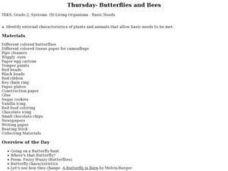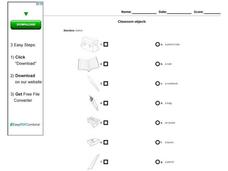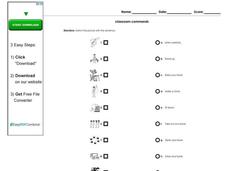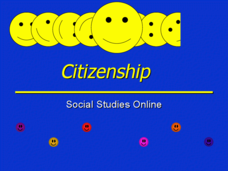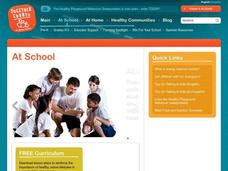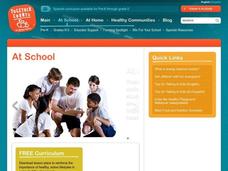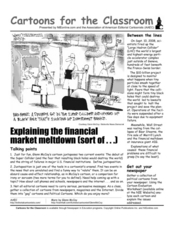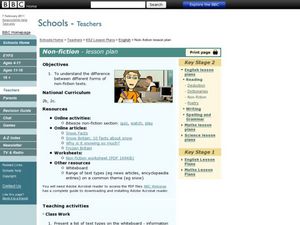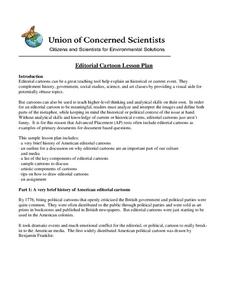Curated OER
Once a fact, always a truth
Students discover there are many sources of accurate and inaccurate information. They use newspapers and, in small groups, develop a statement explaining why they believe the article is accurate or inaccurate.
Curated OER
The Uprising of 1934
Pupils complete a series of activities such as wriing letters to the president, creating collages, analysing photos and newspapers, and journaling related to the strike of 1934.
Curated OER
Digital Picture Books
Second graders create digital picture books reflecting their experiences during the school year on field trips and various classroom activities. Using digital pictures taken during the year, they write captions for each picture and...
Curated OER
Biology: Butterfly Activities
Second graders examine various types of butterflies and insects around their school. They identify differences between beetles and butterflies. Students examine books about butterflies, complete symmetry drawings, and make ladybug key...
Curated OER
Classroom Objects
In this classroom objects word/picture worksheet, students examine 7 pictures that show common school items. Students match these to the word names.
Curated OER
Classroom Commands
In this ESL jobs vocabulary instructional activity, students analyze 7 pictures that depict students at work at school. Students match these pictures to the classroom commands that describe them.
Curated OER
Citizenship
Young students view this presentation which goes over the concepts of being a good citizen, what volunteers do, what our basic rights are, and what types of organizations in our society are considered to be led by volunteers. The last...
Curated OER
Reading Strategies: Main Idea
Identify the main idea and the supporting details of a story in a literacy resource from Discovery Education. Complete with procedures, vocabulary, and assessment activities, this is a great way for pupils to practice their outlining...
Jackson Public Schools
Summer Reading Activities
Provide parents with the tools they need to bridge the summer learning gap with this collection of fun activities. Whether it's creating an alphabet poster with illustrations for each letter, playing a game of sight word concentration,...
Curated OER
I Can Balance. You Can Balance.
It's disturbing to think that one third of children born after the year 2000 will suffer from diabetes and perhaps be the first generation to live shorter lives than their parents! Too many youngsters are not eating properly and are not...
Curated OER
Your Energy Balance Goal!
This is the culminating activity for a unit on energy balance for 3rd-5th graders created by Together Counts. Young learners make a plan to balance their energy in and their energy out for one month. They use the SMART steps in creating...
Curated OER
The Unspoken Words of Media Ethics: Do we know what they are?
Students read codes of ethics from the New York Times, Washington Post, Society of Professional Journalists and the American Society of Newspaper Editors. In this Civics lesson, 10th graders role-play ethical dilemmas faced by reporters.
Curated OER
Political Cartoons
Students examine a variety of historical cartoons. They recognize a political cartoon and identify the main idea, symbolism, exaggeration and caricature in political cartoons. Students analyze a political cartoon by Benjamin Franklin.
Curated OER
Artists Teach Us to See the World through Visual Symbols
Tenth graders analyze a biographical piece of art by Raymond Saunders. They identify shapes, symbols, and lines that are used, and how the piece relates to the artist's life and modern society. They design and create an original piece of...
Curated OER
Iran: 1960-1970
High schoolers read a passage outlining changes that occurred in Iran after WWII, particularly the rise of Ayatollah Khomeini. They answer 5 comprehension questions.
Curated OER
Turning Literature into News
Students analyze the format and structure of various newspaper articles. Then, they rewrite events from literature into news stories about acts of kindness.
Curated OER
Cartoons for the Classrooms: Wall Street Financial Meltdown
Combine two current events (2008) in one political cartoon. This handout examines the Large Hadron Collider, a scientific invention that caused a sudden fear of black holes, and the financial meltdown on Wall Street. Background...
Curated OER
The Ancient Times
Students create a newspaper sharing stories of Cleopatra before her death. They use the internet to research information about her and the time in which she lived. They share their newspaper articles with others.
Curated OER
Pendemonium Unnatural Selection: Quotation Marks
Middle schoolers practice the correct use of quotation marks. For this grammar lesson, students watch and then discuss a video on the use of quotation marks. Middle schoolers find examples of quotation marks in books and periodicals and...
Curated OER
Non-Fiction Texts
Third graders examine different types of non-fiction texts. In this non fiction lesson, 3rd graders use different types of texts to gather information. Students work in groups to analyze the texts for author's purpose, common themes, and...
Curated OER
National Security; The Rosenbergs, Espionage
Students research the history of Julius and Ethel Rosenberg as a lens through which to consider that cases involving a breach of national security tend to be very complicated. They reflect that problems with national security have...
Curated OER
Trains, Telegraphs, and Steamships: War’s New Weapons
Students examine the technological weapons of the Civil War. In this Civil War lesson plan, students research the use of trains, telegraphs, and steamships in the war. Students write newspaper articles pertaining to the new weaponry.
Curated OER
Editorial Cartoon Lesson Plan
Students consider the role of editorial cartoons on American politics. In this editorial cartoons instructional activity, students discover the history of the cartoons in America, analyze some cartoons, and then draw their own cartoons...
Curated OER
Bag Lunch
Students rate foods as safe or unsafe and follow rules for food safety to make them safer.





